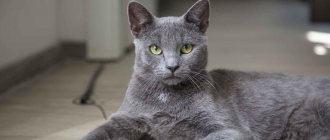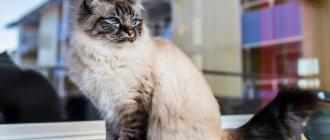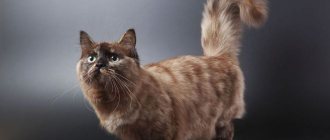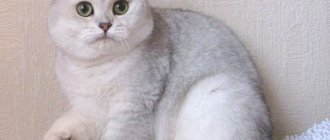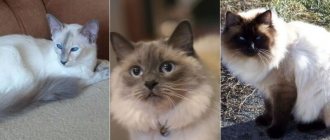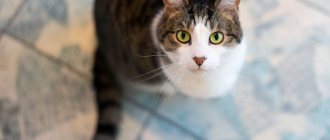Among other cat breeds, the Persian chinchilla stands out for its special, graceful beauty. The reason for this is the elegant color and expressive emerald eyes. Like other Persians, chinchillas have a peaceful and docile character, but at the same time they show curiosity and activity and require the attention of the owner. When keeping an animal, it is important to provide it with a nutritious diet to maintain health, temperament and good coat condition.
History of the breed
Persians are one of the most ancient breeds in the world. An animal of this species was brought to Europe in the 17th century from Iran. The real aristocrat cat was loved by the British for its docile character and impressive appearance. But the silver-colored Persian chinchilla cat was first mentioned only in 1882. Thanks to successful selection, the dark silver coat of the ancestor turned into white hairs with black tips, the standard color for the breed. The first chinchilla kitten became the champion of many international exhibitions, setting an incredibly high bar for his rivals!
The breed was officially registered in 1887.
Next, American breeders joined in the breeding. Over time, Persian chinchillas were replenished with cats with golden and apricot fur, also with dark hair tips.
Kinds
The ancestor of the breed, an original-colored cat named Shinny, was an inhabitant of Mrs. Hart’s nursery in England at the end of the 19th century. It was there that she was first discovered and noted as the owner of a special color, and then acquired by another breeder named Vallance for further breeding and producing offspring with a valuable trait - silver wool.
Further, one of Shinny's male descendants really became very famous, became the winner of many exhibitions, was awarded prizes and went down in history as the first chinchilla cat. It was for him that an exhibition class of such extraordinary cats was founded in 1894.
The first representatives of the silver chinchilla breed had a pure silver color, marked by an indeterminate tabby pattern, which is now commonly called ghostly or shadow. But they were few in number, and therefore to continue the family it was necessary to cross them with blue, smoky, and silver tabbies of different colors.
This interfered with the conservation of the breed. Therefore, the color of its representatives of those times could not be called established. The cats looked either too dark or unevenly colored. And only with an increase in the number of suitable applicants (around 1930) did the possibility of targeted selection become possible.
Initially, there was only the Persian (as it was later named) long-haired subspecies. According to color, its representatives were divided into “silver shaded” cats, too dark in color, and real chinchillas - lighter, the ends of whose hair were colored only an eighth of the total length.
Silver Chinchilla Persian
New specimens of the so-called ticked chinchillas have also appeared, that is, cats that do not have stripes or spots in their colors, whose hair is colored evenly, but differs in shade in different zones, which gives the effect of a slight shimmer and an impressive play of color.
Ticked chinchilla
The Persian subspecies still exists. Such specimens are distinguished by luxurious arctic fox fur, emerald eye color, a nose resembling a red brick, black paw pads and lips. In those days, this type was crossed with exotic and British cat breeds, which yielded results and the emergence of new subspecies.
The British silver chinchilla cannot boast of long hair, unlike its ancestors. It has a short coat, but its fur is famous for its thickness and fluffiness.
The coloring of such creatures, like other true chinchillas, is white with colored ends of the hair, a peculiar dark coating, the shade of which can be very individual in different individuals.
Green eyes with dark eyeliner stand out against the background of delightful fur, which makes them unusually expressive with such “makeup”.
The Scottish silver chinchilla was also bred from long-haired Persians . Typically, such specimens have medium-length hair, but, in fact, in terms of external characteristics they are not much different from the British, which is not surprising, because these two subspecies are very closely related. When breeding Scots, representatives of the British subspecies were used quite often.
Chinchilla ears can be erect, that is, the most common, and also strike a very original “owl” shape. Instances of the latter have ears tightly pressed to the head, repeating its outline, which are practically invisible.
A cat with a similar trait is usually called a silver fold chinchilla . These are considered especially exotic.
Appearance characteristics
Appearance of Persian chinchillas
Chinchillas are distinguished from ordinary Persians by their unique color; otherwise, the parameters of the breeds are the same:
- The round head appears massive due to the convex forehead, full cheeks and strong chin.
- The nose is small, wide, slightly upturned. The lobe is brick red, but the golden varieties have a paler hue.
- The ears are also small, low and wide set. The rounded tips end in fluffy tassels.
- The eyes are large and almond-shaped. The outline of the eyes and lips is outlined in black (the color of the iris in chinchillas: all shades of green).
- The coat is thick, long, thin, which is why it is silky to the touch.
- The tail consists of hairs that are 2 cm longer than those on the body, which is why it appears very fluffy.
For all their subtlety and elegance, these are very hardy cats.
Color of Persian chinchilla cats
The Persian cat, in the silver chinchilla variety, has tipping: a type of color in which only the upper 1/8 of the hair is pigmented, while the remaining part remains completely white. This color is called veiled when it seems as if a veil has been thrown over the wool, which makes the wool shimmer and sparkle.
Traditionally the tipping is dark, but in recent years breeders have developed varieties with blue chocolate, lilac, tortoiseshell, red and cream tips. The photo shows chinchilla Persians of silver and cream color.
Persian chinchillas with silver and cream tipping
In classic-colored cats, the dark pigment stands out most in the area of the ears, tail, and paws. It is characteristic that in short-haired animals the contrast in color is more pronounced. It seems as if the fur is illuminated from the inside.
Dimensions and weight
The size and weight of adult Persian chinchilla cats is 28 cm at the withers and 4 kg, respectively, males are 33 cm and 7 kg or more.
These are cats with muscular bodies and paws. They have a proportional structure, but due to the length of their fur, their limbs appear shortened. Strong bones and broad chest and shoulders add to the majestic appearance.
What color can a Persian chinchilla be?
The Persian chinchilla is a snow-white cat. However, there is a veiled variety of color. The animals have pigmented tips of their hairs. Therefore, several shades are possible:
- Persian silver chinchilla (blue);
- black;
- tortoiseshell (typical of females);
- chocolate;
- apricot or yellow;
- lilac.
The Persian silver chinchilla , as well as the golden variety, are especially beautiful. They seem to be wearing light tulle or gauze dresses. The nose of a creature of this color is lighter than that of other color variants. They are characterized by beautiful eyes of bright green or bright blue tones.
Character and behavior
The Persian Chinchilla breed of domestic cats has such common features as intelligence, calmness, and sociability. In a home with such a cat, an aura of peace and peaceful existence appears.
They build a special relationship with the owner: they move from room to room following the owner, on occasion they sit on the lap, feel the mood and “turn on” the hunting mode when you are ready to play. Persians are smart cats, so if he sees that you don’t have time for him, he won’t fuss or meow, he’ll easily find something to do that interests him, play or fall asleep on his favorite blanket.
Silver Persian chinchillas bring peace and tranquility to the home
When choosing a pet, you need to take into account that Persian cats are not ready for adventure and other four-legged pets in the house. Despite the fact that this is one of the calmest cat breeds, they are jealous of their relationship with their owner. An animal that is more active than a chinchilla will cause an aggressive reaction in the latter, as it disturbs its peace. Exceptions are cats of the same breed or if the pets grew up together.
These cats are very sensitive. Try not to raise your voice, even if the kitten has done something wrong, otherwise your relationship will be ruined by the pet’s long-term resentment.
Why do felinologists and owners value the breed?
People are attracted by the noble white color of the animal's coat. It resembles the fur of an Angora cat. The animal's hair is famous for its tenderness and fluffiness.
The Persian chinchilla cat breed attracts attention with its expressive look. This is facilitated by the flattened muzzle and bright green tint of the eyes. It seems that the wool queen drew arrows on her eyelids. Other benefits of pets:
- the Persian chinchilla has ideal body proportions;
- the rounded muzzle gives the animal a good-natured appearance;
- long beautiful wool;
- a small nose is a characteristic of all Persians;
- impressive size (adult cats and female cats weigh from 4 to 7 kilograms).
The Persian chinchilla is a cat with a bushy tail. The hair on this part of the body is 20 mm longer than in other places. Therefore, the woolly king can use its tail as a fan.
Care instructions
Persian chinchilla after grooming
What makes this breed beautiful are its large green eyes and long, silky coat. With proper care, the cat will feel comfortable and will not harm itself.
- Wool. The breed's peculiarity (short tongue) does not allow the Persian to fully take care of his beautiful fur, so he needs the help of his owner. It is recommended to comb out every day, using a slicker brush and a comb with sparse metal teeth. First, in the direction of hair growth (tummy, chest, hind legs, head, back, tail), then, if necessary, against hair growth. If tangles have formed, they are usually cut off. You should also comb the fur between your fingers: matted fur causes great discomfort when walking.
- Bathing. No more than once every two months (if the cat is exclusively at home). For water treatments, choose a specialized shampoo for long-haired dogs; it will minimize the likelihood of tangles forming. To make their fur shiny, show chinchillas are additionally washed with tint products for light fur. Be sure to rinse thoroughly and blow dry your pet to remove any dead hair. If your cat is very afraid of bathing, use dry shampoo and clean dirty areas with a damp cloth. It is strictly not recommended to use human means. The presence of strong flavors, additives and other products that are harmless to humans can have a negative impact on your pet’s health.
- Eyes. The flattened muzzle and poorly formed eye canal lead to frequent tearing in Persians. In this case, they are at high risk of becoming infected with pathogenic bacteria. To prevent the onset of the inflammatory process, it is recommended to wipe the eyes with a sponge soaked in eye drops, chamomile decoction or saline solution.
- Ears. The same as with the eyes. Once a week it is necessary to treat them with a cotton pad and a special solution.
- Claws. Trim once a week if your pet does not sharpen them themselves.
- Teeth. If necessary, clean with a cat toothbrush and toothpaste. For complete health, it is recommended to remove tartar with ultrasound once a year.
The cat's litter box also requires care. In addition to regular cleaning after the cat has visited it, once a month you can pour boiling water over the tray.
Care and maintenance
These creatures, who tend to behave with true royal dignity, in everyday life turn out to be far from being as demanding and picky as it might seem at first.
A big advantage of the breed is that by nature its representatives are endowed with quite good health. However, the care and nutrition regimen should still be followed in order to protect such noble pets from troubles and diseases.
And the first point that should be noted as requiring special attention is the need to monitor the magnificent fur of such pets. Regardless of whether the cat's fur is long or short, it must be combed at least a couple of times every seven days.
The silver chinchilla's coat needs to be brushed once a week.
This procedure is undoubtedly important because excess hair negatively affects the well-being of such high-breed creatures. In addition, it is clear that wool in the house, left in different parts of the home: on furniture in rooms, carpets on the floor and clothes of the owners, does not have a positive effect on the hygiene of the room, and can also cause an allergic reaction.
Another important procedure is monthly bathing. And after this, it is recommended to examine the animal’s eyes, teeth and ears for contamination and the presence of inflammatory foci in them. This is important especially in the summer, because the heat makes it difficult for the cat to breathe and also provokes unwanted discharge in animals. What becomes a consequence of purulent inflammation.
It is better for the owner if he makes it a rule to treat such a sensitive and intelligent pet without irritation, violence, screaming and pressure. Otherwise, the reaction to injustice in a silver chinchilla cat may turn out to be the most unpredictable.
She is independent and loves freedom, and, therefore, she needs personal space - her own camphor and cozy corner for relaxation, which should be equipped with love and taking into account the animal’s personal preferences.
Catering
What to feed Persian chinchillas
If your pet does not have individual diseases or other problems that require special nutrition, you can rely on the standard menu for this breed:
- Boiled beef/chicken/turkey fillet;
- Beef and chicken by-products;
- Protein foods (for example, boiled eggs);
- Lean sea fish (no more than 10% of the weekly diet);
- Vegetables or vitamin supplements recommended by a veterinarian;
You can switch your cat to premium dry food, the composition of which is tailored to this breed. In this case, make sure that your pet always has access to fresh drinking water.
Purebred Persian cats are picky eaters. But if the owner listens to the wishes of the pet, he will thank him with peaceful purrs for many years.
Kittens
The Persian breed is most active in childhood. He enthusiastically explores the apartment, attacks a fly hiding on the wallpaper, or disappears into the wilds of the country lawn, revealing ancient instincts. Early returns may be susceptible to food allergies, so try to introduce them to quality dry food.
How long do Persian cats live? Pets may be susceptible to skull deformation, eye diseases, and have breathing problems
. But one way or another, the average life expectancy is 14-15 years. There is an opinion that male Persians are more active and aggressive, while females are docile and gentle. But in reality this is far from the case. It is the female Persians who show greater independence and autonomy. You should take this fact into account when purchasing a pet.
Interesting!
The average cost of a Persian cat in the world is from 300 to 800 US dollars.
Genetics and health
Since chinchillas come from the Persian breed, all the pathologies inherent in the Persians were also passed on to them:
- snoring during sleep from congenital deformation of the nasal septum;
- eye infection due to watery eyes;
- polycystic kidney disease, which causes kidney failure;
- gingivitis, periodontitis – inflammation of the gums;
- hypertrophic cardiomyopathy (thickening of the heart muscles);
- dermatitis (brown discharge around the nose and eyes).
Chinchillas are a fairly strong breed. Therefore, do not be alarmed by the number of possible diseases. To prevent them, you just need to periodically examine your pet at the veterinarian. In developing cases, he will prescribe the necessary supportive therapy.
Golden Persian chinchilla
The owner can reduce the risk of contracting certain diseases by following simple hygiene rules: wash hands after going outside, keep the cat away from outerwear and shoes. In order to prevent your pet from catching a cold, you need to protect it from hypothermia: dry it after bathing, do not walk in bad weather, do not feed it cold food. And, of course, timely vaccination of the animal is necessary.
Types of Persian cats
Persian cats were domesticated several centuries ago, and since then their appearance has undergone many changes. Thanks to breeders, today there are several types of this breed.
Depending on the color, there are about 100 varieties. Cats can have a single color, or they can consist of several colors and shades.
The most noticeable distinguishing feature in the description of a Persian cat is its nose. It is small, wide and snub-nosed. There are several types of Persian noses. Depending on its type, there are several types of Persian cats:
- Classic British - straight nose, located just below eye level
- European - snub nose, the upper edge of which is at the same level as the lower eyelids
- Extreme - snub nose, which is located on the same level with the upper eyelid.
Previously, there was another type of Persian cat - peakface. Their nose was located above the level of the upper eyelid. Their breeding was prohibited due to significant health problems
These cats have: breathing problems, constant lacrimation, malocclusion, problems eating. Such cats lived very rarely. The extreme type of Persians is the result of selection taking into account the rules of humane treatment of animals.
Tolerance for children
Chinchilla cats get along well with children of any age, from toddlers to teenagers. They do not release their claws and do not use their teeth even against the unpleasant actions of their “little master.” At the behest of his character, if the cat is completely uncomfortable, he will calmly go to another place.
If you are planning to take a cat as a companion for your child, you can't find a better place for children! They will grow up together, explore the world around them, and go for walks. The cat also shares his tranquility (see the photo below!), which has a positive effect on the psychological state of the child and any other family member.
Persian chinchillas are friendly with children of any age.
Reproduction and lifespan
Selecting a suitable partner for cats of this breed, if you want to get offspring with the required hair quality, is not an easy task and requires a lot of knowledge in the field of animal breeding.
The silver type color is divided into several groups:
- darkened silver (the colored tip of the hair is no more than an eighth of the length);
- ticked (with alternating several light and at least three dark zones on the hair);
- silver shaded (colored at the tip for a third of the length).
Errors in selecting pairs for mating can result in the appearance of silver chinchilla kittens with undesirable hair color. This makes it difficult for the breed to develop. And restoration of the necessary qualities takes two, or even three generations. At the same time, the progressive features of purebred chinchillas may be completely lost.
The problem is also the eye color of these cats. Initially, it was believed that in purebred representatives it must be turquoise (greenish-blue). Later, bright yellow and orange eyes were accepted as acceptable.
But although there are more than enough difficulties, however, thanks to the efforts of breeders and the hard work of breeders, the chinchilla breed is constantly being improved. And even if the kitten does not become a prize-winner at exhibitions, it still pleases its owner.
Such a sublime creature, captivating hearts at first sight, will decorate any home and easily make friends with its inhabitants. The approximate lifespan of such pets, which are naturally in good health, is approximately 15 years.
How to choose a kitten and its cost
Kittens are ready to go from the age of two months. By this time, a good breeder will have trained the kittens to litter box and feed themselves. In addition, at two months of age it is already possible to determine the individual character of a kitten, so you can choose a specimen that is suitable in temperament.
Representatives of purebred Persian chinchillas cost from 10,000 rubles. Moreover, the pedigree of such a cat consists of show parents and is also intended for breeding. If the owner does not pursue such goals, it is possible to find a kitten for 500-1000 rubles.
Before purchasing, be sure to inspect the animal; a representative of the breed must have all the phenotypic and physiological characteristics of its species.
Description and features
There are plenty of exquisite cats in the world. And among the most amazing and beautiful breeds of these graceful charmers, one can highlight the silver chinchilla . It should be noted that this name was received by these cats for a very special type of plush coat with an impressive silver color.
This animal’s coat is very reminiscent of the thick fur of the cute rodent chinchilla, which has long been famous for its tenderness and play of light tints. In honor of the mentioned funny animal, this breed received its unique name.
The silver effect in such cats is created due to a light touch of dark on light fur. Visually, this gives the impression of a veil draped over the body of a four-legged creature, which also extends to the animal’s tail and its paws.
The appearance of this wonderful creature is clearly visible in the photo of a silver chinchilla . Her entire being exudes royal dignity, majestic strength and silent calm. These qualities are confirmed not only by appearance, but also by character and behavior.
Silver chinchillas have a calm character
This cat is distinguished by its flexibility, extraordinary insight and intelligence, and intellectual restraint. Such an animal does not show nervousness, does not scratch others over trifles, does not have the habit of damaging the owner’s furniture in comfortable homes, and adapts perfectly to a wide variety of conditions.
The chinchilla considers it beneath his dignity to violently express emotions: satisfaction or irritation. Natural patience gives her the ability to endure long-term loneliness. But if a beloved owner comes home, then this sweet creature will definitely find a way to express her deepest respect, devotion and love towards him.
Restraint and aristocracy are inherent in this breed even in kittens. In the morning, they tactfully wait for their patrons to wake up before rewarding them with their caresses and demanding attention and care from them. This shows the nobility of the breed.
Adult cats are incredibly smart, and even meow with a certain intonation, by which you can easily guess their thoughts, emotions and moods. Moreover, they love to communicate with their owners, which broadens their horizons and shows a desire for active improvement.
But even such domestic creatures show curiosity and activity strictly in moderation. In addition, they cannot tolerate interference from bipeds into their personal space. People can pet them, but they won’t allow themselves to be squeezed. And when they feel the need, they may well show persistent stubbornness if they see that their interests are being violated.
In this case, putting pressure on them and even persuading them is completely useless. They become attached to only one of the two-legged patrons, recognizing him as the true owner, but they love him with all the devotion of a cat’s heart.
How to behave with chinchillas?
You can only communicate with your pet in a calm voice.
If the owner's tone is not to her liking, the cat may be offended and the owner will lose her trust.
Be sure to read:
Burmese sacred cat: appearance, character, price, care and maintenance of the breed
You need to communicate with a chinchilla only in a calm voice.
Animals appreciate attention and begin to waste away if they are not noticed, so chinchillas are not suitable for families where the owner is often absent.
Golden Chinchilla Standards
For the first time, the golden chinchilla color was included in the standard of Persian cats. Now it is found in many breeds for which the silver chinchilla color is recognized.
Preference is given to cats with a uniform golden undercoat without a gray area at the roots. When the color first appeared, such animals were still used for breeding, but now they are increasingly not allowed to breed.
There is no single standard regulating the color of the golden chinchilla. Experts evaluate animals in accordance with documents approved for a specific breed by the World Cat Federation:
- British cats are stocky, massive and muscular. The head is round, with a wide skull and pronounced cheeks. The ears are small, set wide, and the tips are slightly rounded. The tail is thick and curves upward. The coat is raised, dense and short.
- Scottish - divided into fold-eared (Scottish fold) and straight-eared (straight). The first ones have small ears, the tips hanging forward. The limbs are short and thick. Straights have erect ears and can be small or medium in size. The limbs are slightly longer and lighter.
- Persian - distinguished by rectangular body lines. Legs are strong and short. The head is large, the forehead is sloping (other chinchillas have a rounded forehead).
Golden chinchillas have ears covered with dense and short fur. The eyes are very large and expressive.
Education and physical activity
The mobility of Persian chinchillas directly depends on age. Kittens and young animals love to play and have no problem finding entertainment. With age, the activity of chinchilla Persians decreases. And to prevent cats from becoming lazy, it is recommended to interest them in games with a laser pointer, balls or artificial mice.
Representatives of the breed are highly intelligent and easily remember something new. Chinchilla Persians are easily litter trained and quickly learn the rules of behavior in the house.
What affects the lifespan of a Persian
The lifespan of a Persian cat, like any other, depends on various factors:
- habitat;
- diet;
- veterinary care;
- body mass;
- breed subspecies;
- genetic diseases;
- acquired diseases;
- proper care;
- love and affection.
The lifespan and health of a Persian will depend largely on its subspecies. Extreme Persians often have significantly more health problems and a shorter life expectancy than classic British and European ones. They have a tendency to the following hereditary health disorders:
- polycystic kidney disease;
- loss of vision;
- increased lacrimation;
- hypertrophic cardiomyopathy;
- diseases of teeth and gums.
Due to the structural features of the muzzle, extreme Persians experience breathing problems, so you need to constantly monitor the condition of the nostrils - dust and debris often accumulate in them.
Persian cats of any kind cannot live outdoors or in the wild. They cannot obtain food on their own and cannot resist their brothers of other breeds.
Training
Persians are smart and quick-witted cats, they catch on the fly and are always ready to please their owner. Relationships with your pet should be built without aggression, on love and affection. Avoid rudeness, sudden movements and loud sounds. Accustom to one command at a time, while taking into account the animal’s capabilities when setting the task. Compliance with requirements is encouraged with affection, and immediate punishment for misconduct (loud bang, splashing with water).
You need to play with the animal several times a day so that it does not become depressed. This will have a beneficial effect on the physical and emotional state of the pet. When picking up, it is important to ensure that the paws have support. With regular communication, the pet will learn to pick up the intonation of the voice and the mood of the owner. You should enjoy games and spending time together.



